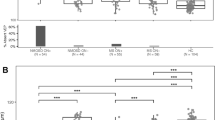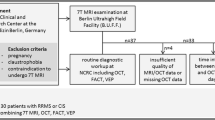Abstract
Asymptomatic visual loss is a feature of multiple sclerosis (MS) but its relative impact on distinct retinocortical pathways is still unclear. The goal of this work was to investigate patterns of subclinical visual impairment in patients with MS with and without clinically associated previous optic neuritis (ON). We have used functional methods that assess parvo-, konio- and magnocellular pathways in order to compare pathophysiological mechanisms of damage in a population of 44 subjects with MS (87 eyes), with and without a previous episode of ON. These methods included chromatic contrast sensitivity across multiple chromatic axes (Cambridge Colour Test–parvo/konio pathways), perimetric achromatic contrast sensitivity for the magno pathway [frequency doubling technique (FDT)] and pattern visual evoked potentials (VEP). These measures were correlated with field sensitivity measures obtained using conventional automated static perimetry (ASP) and were also compared with conventional clinical chromatic/achromatic contrast sensitivity chart-based measures. We have found evidence for uncorrelated damage of all retinocortical pathways only in patients with MS without ON. VEP evidence for axonal damage was found in this group supporting the emerging notion of axonal damage even in sub-clinical stages of ON/MS pathophysiology. Only in this group was significant correlation of functional measures with disease stage observed, suggesting that distinct pathophysiological milestones are present before and after ON has occurred.





Similar content being viewed by others
References
Shapley RM, Hawken JM (1999) Parallel retino-cortical channels and luminance. In: Gegenfurtner KR, Sharpe LT (eds) Color vision: from genes to perception. Cambridge University Press Cambridge, UK, pp 221–234
Harrison AC, Becker WJ, Stell WK (1987) Colour vision abnormalities in multiple sclerosis. Can J Neurol Sci 14:279–285
Travis D, Thompson P (1989) Spatiotemporal contrast sensitivity and colour vision in multiple sclerosis. Brain 112:283–303
Porciatti V, Sartucci F (1996) Retinal and cortical evoked responses to chromatic contrast stimuli. Specific losses in both eyes of patients with multiple sclerosis and unilateral optic neuritis. Brain 119:723–740
Caruana PA, Davies MB, Weatherby SJ, Williams R, Haq N, Foster DH et al (2000) Correlation of MRI lesions with visual psychopysical deficit in secondary progressive multiple sclerosis. Brain 123:1471–1480
Optic Neuritis Study Group (1997) The 5-year risk of MS after optic neuritis. Experience of the optic neuritis treatment trial. Neurology 49:1404–1413
Ghezzi A, Martinelli V, Rodegher M, Zaffaroni M, Comi G (2000) The prognosis of idiopathic optic neuritis. Neurol Sci 21:865–869
Parisi V, Manni G, Spadaro M, Colacino G, Restuccia R, Marchi S et al (1999) Correlation between morphological and functional retinal impairment in multiple sclerosis patients. Invest Ophthalmol Vis Sci 40:2520–2527
Korsholm K, Madsen KH, Frederiksen JL, Skimminge A, Lund TE (2007) Recovery from optic neuritis: an ROI-based analysis of LGN and visual cortical areas. Brain 130:1244–1253
Polman CH, Reingold SC, Edan G, Filippi M, Hartung HP, Kappos L et al (2005) Diagnostic criteria for multiple sclerosis: 2005 revisions to the “McDonald Criteria”. Ann Neurol 58:840–846
Kurtzke JF (1983) Rating neurologic impairment in multiple sclerosis: an expanded disability status scale (EDSS). Neurology 33:1444–1452
Regan BC, Reffin JP, Mollon JD (1994) Luminance noise and the rapid determination of discrimination ellipses in colour deficiency. Vision Res 34:1279–1299
Castelo-Branco M, Faria P, Forjaz V, Kozak LR, Azevedo H (2004) Simultaneous comparison of relative damage to chromatic pathways in ocular hypertension and glaucoma: correlation with clinical measures. Invest Ophthalmol Vis Sci 45:499–505
Campos SH, Forjaz V, Kozak LR, Silva E, Castelo-Branco M (2005) Quantitative phenotyping of chromatic dysfunction in Best macular distrophy. Arch Ophthalmol 123:944–949
Silva MF, Faria P, Regateiro FS, Forjaz V, Januário C, Freire A et al (2005) Independent patterns of damage within magno-, parvo- and koniocellular pathways in Parkinson′s disease. Brain 128:2260–2271
Roth A, Lanthony P (1999) Vision des Couleurs. In: Risse JF (ed) Exploration de la fonction visuelle. Applications au domaine sensorial de l’oeil normal et en pathologie. Société Française d’Opthtalmologie et Masson, Paris, pp 129–151
Rayleigh L (1881) Experiments on colour. Nature 25:64–66
Moreland JD, Kerr J (1978) Optimization of stimuli for tritanomaloscopy. Mod Prob Ophthalmol 19:162–166
Kelly DH (1966) Frequency doubling in visual responses. J Opt Soc Am 56:1628–1633
Sakai T, Matsushima M, Shikishima K, Kitahara K (2007) Comparison of standard automated perimetry with matrix frequency-doubling technology in patients with resolved optic neuritis. Ophthalmology 114:949–956
Castelo-Branco M, Mendes M, Silva MF, Januário C, Machado E, Pinto A et al (2006) Specific retinotopically based magnocellular impairment in a patient with medial visual dorsal stream damage. Neuropsychologia 44:238–253
Roth A, Lanthony P (1999) Fonctions de sensibilité au contraste de luminance. In: Risse JF (ed) Exploration de la fonction visuelle. Applications au domaine sensorial de l’óeil normal et en pathologie. Société Française d’Opthtalmologie et Masson, Paris, pp 81–98
Morales J, Weitzmann ML, González de la Rosa M (2000) Comparison between tendency-oriented perimetry (TOP) and octopus threshold perimetry. Ophthalmology 107:34–42
Brusa A, Jones SJ, Plant GT (2001) Long-term remyelination after optic neuritis: a 2-year visual evoked potential and psychophysical serial study. Brain 124:468–479
Brusa A, Jones SJ, Kappor R, Miller DH, Plant GT (1999) Long term recovery and fellow eye deterioration after optic neuritis, determined by serial visual evoked potential. J Neurol 246:776–782
Silva MF, Maia-Lopes S, Mateus C, Guerreiro M, Sampaio J, Faria P et al (2008) Retinal and cortical patterns of spatial anisotropy in contrast sensitivity tasks. Vision Res 48:127–135
Moura AL, Teixeira RA, Oiwa NN, Costa MF, Feitosa-Santana C, Callegaro D et al (2008) Chromatic discrimination losses in multiple sclerosis patients with and without optic neuritis using the Cambridge colour test. Vis Neurosci 25:463–468
Mullen KT, Plant GT (1986) Colour and luminance vision in human optic neuritis. Brain 109:1–13
Evangelou N, Konz D, Esiri MM, Smith S, Palace J, Matthews PM (2001) Size-selective neuronal changes in the anterior optic pathways suggest a differential susceptibility to injury in multiple sclerosis. Brain 124:1813–1820
Noval S, Contreras I, Rebolleda G, Munoz-Negrete FJ (2006) Optical coherence tomography versus automated perimetry for follow-up of optic neuritis. Acta Opthalmol Scand 84:790–794
Fisher JB, Jacobs DA, Markowitz CE, Galetta SL, Volpe NJ, Nano-Schiavi ML et al (2006) Relation of visual function to retinal fiber layer thickness in multiple sclerosis. Ophthalmology 113:324–332
Frederiksen JL, Petrera J (1999) Serial visual evoked potential in 90 untreated patients with acute optic neuritis. Surv Ophthalmol 44:54–62
Sater RA, Rostami AM, Galetta S, Farber RE, Bird SJ (1999) Serial evoked potential studies and MRI imaging in chronic progressive multiple sclerosis. J Neurol Sci 171:79–83
Henderson AP, Trip SA, Schlottmann PG, Altmann DR, Garway-Heath DF, Plant GT et al (2008) An investigation of the retinal nerve fibre layer in progressive multiple sclerosis using optical coherence tomography. Brain 131:277–287
Wray SH (1994) Optic neuritis. In: Albert DM, Jakobiec FA (eds) Principles and practise of ophthalmology. Pa, WB Saunders, Philadelphia, pp 2539–2550
Gout O, Lebrun-Frenay C, Labauge P, Le Page GE, Clavelou P, Allouche S, PEDIAS Group (2011) Prior suggestive symptoms in one-third of patients consulting for a “first” demyelinating event. J Neurol Neurosurg Psychiatry 82:323–325
Noble J, Forooghian F, Sproule M, Westall C, O’Connor P (2006) Utility of the national eye institute VFQ-25 questionnaire in a heterogeneous group of multiple sclerosis patients. Am J Ophthalmol 142(3):464–468
Acknowledgments
This research was funded by grants from the Portuguese Science and Technology Foundation (FCT): PTDC_SAU_NEU_68483_2006 and PIC/IC/82986/2007, as well as by the National Brain Imaging Network of Portugal (BIN).
Conflict of interest
The authors declare that they have no conflict of interest.
Author information
Authors and Affiliations
Corresponding authors
Electronic supplementary material
Below is the link to the electronic supplementary material.
Rights and permissions
About this article
Cite this article
Reis, A., Mateus, C., Macário, M.C. et al. Independent patterns of damage to retinocortical pathways in multiple sclerosis without a previous episode of optic neuritis. J Neurol 258, 1695–1704 (2011). https://doi.org/10.1007/s00415-011-6008-y
Received:
Revised:
Accepted:
Published:
Issue Date:
DOI: https://doi.org/10.1007/s00415-011-6008-y




